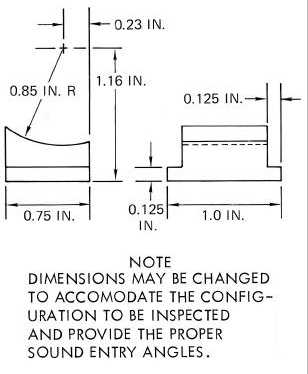T.O. 33B-1-1
5-37
Figure 5-39. Typical Curved Surface.
g. Although shoes for curved surfaces are usually fabricated from acrylic plastic, sometimes shoes are
fabricated from the same material as the test part. With shoes of the test part material, the sound beam
travels straight into the test part from the shoe; refraction does not occur.
h. The radius of curvature of each shoe should match the radius of curvature of the test part. Small
changes in the curvature of the shoe can be accomplished on the test part by inserting number 400 or
finer grit sandpaper between the shoe and the test part and then sliding the shoe across the sandpaper.
Major shaping of a shoe should be done in a machine shop, because the shoe cannot be held steady
enough by hand.
i. In some cases, when using plastic shoes for angle beam inspection on curved surfaces, the portion of the
sound beam away from the beam center may produce unwanted longitudinal and/or surface waves as
shown in Figure 5-41. This effect increases with decreasing radii of curvature. Also, when using large
angles (70° or larger) for inspecting cylindrical shapes in the longitudinal direction, interfering surface
waves can be generated. These waves leave the shoe on both sides at an angle to the longitudinal
direction (see Figure 5-40). In these cases, it is not desirable to adapt the shoe to a close fit with the
part. The shoe should be made so that only the central portion of the beam centers the test part. As an
option, slots may be cut in the bottom surface of the shoe. The slots should be oriented perpendicular to
the direction of propagation of the unwanted surface waves and located away from the exiting beam
center (see Figure 5-42). The dimensions of the slots should be about 1/8 inch wide by 1/8 inch deep.

